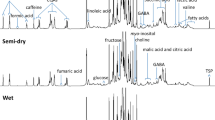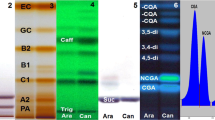Abstract
The wild diversity of the Coffea genus is large, which is valuable for coffee plant breeding programs intended to obtain higher sensory quality varieties; but a biochemical characterization of accessions, already available in coffee germplasm banks, is still needed. In this work, a quantitative determination of caffeine, trigonelline and 5-caffeoylquinic acid (5-CQA), in coffee leaves of 80 different Coffea spp. accessions from the Coffee Germplasm Bank located in Huatusco, Veracruz, Mexico was done. These metabolic variables might be useful as quality-related selection markers in future coffee breeding programs. Fresh coffee leaves from each accession were processed and metabolites determined by UPLC-MS/MS analyses. Multidimensional Scaling (MDS), Hierarchical Cluster Analysis (HCA) and Analysis of Variance (AOV) revealed that levels of caffeine and trigonelline in leaves significantly varied among accessions, from 0.00 to 2.04% (w/w) and from 0.42 to 1.82% (w/w), respectively. While 5-CQA ranged from 0.00 to 0.66%. In C. liberica no caffeine was detected, demonstrating that coffee leaves have the potential to be used in the genetic profiling of Coffea spp. These results could be useful in formulating a proposal for intraspecific crosses in C. arabica, for the generation of F1 hybrids with good cup quality attributes, while in C. canephora they could be helpful for enhancing sensory quality traits of Robusta coffees.



Similar content being viewed by others
Availability of data and material
Dataset is available from Mendeley at https://dx.doi.org/10.17632/9hjtpksb9v.1 (under embargo until July 10, 2020 at 12:00 am UTC).
References
Davis AP, Tosh J, Ruch N, Fay MF (2011) Growing coffee: Psilanthus (Rubiaceae) subsumed on the basis of molecular and morphological data; implications for the size, morphology, distribution and evolutionary history of Coffea. Bot J Linn Soc 167(4):357–377
Butt MS, Sultan MT (2011) Coffee and its consumption: benefits and risks. Crit Rev Food Sci Nutr 51(4):363–373
Figueiredo LP, Borém FM, Ribeiro FC, Giomo GS, Malta MR, da Taveira JHS (2018) Sensory analysis and chemical composition of ‘bourbon’ coffees cultivated in different environments. Coffee Sci 13(1):122–131
Farah A, Monteiro MC, Calado V, Franca AS, Trugo LC (2006) Correlation between cup quality and chemical attributes of Brazilian coffee. Food Chem 98(2):373–380
Lemos MF, Perez C, da Cunha PHP, Filgueiras PR, Pereira LL, Almeida da Fonseca AF et al (2020) Chemical and sensory profile of new genotypes of Brazilian Coffea canephora. Food Chem 310:125850. https://doi.org/10.1016/j.foodchem.2019.125850
Chen X (2019) A review on coffee leaves: phytochemicals, bioactivities and applications. Crit Rev Food Sci Nutr 59(6):1008–1025
Chen X, Mu K, Kitts DD (2019) Characterization of phytochemical mixtures with inflammatory modulation potential from coffee leaves processed by green and black tea processing methods. Food Chem 271:248–258
de Almeida RF, Trevisan MTS, Thomaziello RA, Breuer A, Klika KD, Ulrich CM et al (2019) Nutraceutical compounds: Echinoids, flavonoids, xanthones and caffeine identified and quantitated in the leaves of Coffea arabica trees from three regions of Brazil. Food Res Int 115:493–503
Souard F, Delporte C, Stoffelen P, Thévenot EA, Noret N, Dauvergne B et al (2018) Metabolomics fingerprint of coffee species determined by untargeted-profiling study using LC-HRMS. Food Chem 245:603–612
Tran HTM, Vargas CAC, Slade Lee L, Furtado A, Smyth H, Henry R (2017) Variation in bean morphology and biochemical composition measured in different genetic groups of arabica coffee (Coffea arabica L.). Tree Genet Genomes 13(3):54
Chen XM, Ma Z, Kitts DD (2018) Effects of processing method and age of leaves on phytochemical profiles and bioactivity of coffee leaves. Food Chem 249:143–153
Ngamsuk S, Huang T-C, Hsu J-L (2019) Determination of phenolic compounds, procyanidins, and antioxidant activity in processed Coffea arabica L. leaves. Foods 8(9):389
Clifford MN, Johnston KL, Knight S, Kuhnert N (2003) Hierarchical scheme for LC-MS n identification of chlorogenic acids. J Agric Food Chem 51(10):2900–2911
Campa C, Urban L, Mondolot L, Fabre D, Roques S, Lizzi Y et al (2017) Juvenile coffee leaves acclimated to low light are unable to cope with a moderate light increase. Front Plant Sci 8:1126
Garrett R, Schmidt EM, Pereira LFP, Kitzberger CSG, Scholz MBS, Eberlin MN et al (2013) Discrimination of arabica coffee cultivars by electrospray ionization Fourier transform ion cyclotron resonance mass spectrometry and chemometrics. LWT Food Sci Technol 50(2):496–502
Jumhawan U, Putri SP, Yusianto BT, Fukusaki E (2015) Application of gas chromatography/flame ionization detector-based metabolite fingerprinting for authentication of Asian palm civet coffee (Kopi Luwak). J Biosci Bioeng 120(5):555–561
Zhang C, Wang C, Liu F, He Y (2016) Mid-infrared spectroscopy for coffee variety identification: comparison of pattern recognition methods. J Spectrosc 2016:1–7
Craig AP, Fields C, Liang N, Kitts D, Erickson A (2016) Performance review of a fast HPLC-UV method for the quantification of chlorogenic acids in green coffee bean extracts. Talanta 154:481–485
Defernez M, Wren E, Watson AD, Gunning Y, Colquhoun IJ, Le Gall G et al (2017) Low-field 1H NMR spectroscopy for distinguishing between arabica and robusta ground roast coffees. Food Chem 216:106–113
Gruz J, Novák O, Strnad M (2008) Rapid analysis of phenolic acids in beverages by UPLC–MS/MS. Food Chem 111(3):789–794
Cortés FM, Pérez SJA, Servín JR, Morales RV (2020) Relationship between physico-chemical properties in the coffee beans and the cup quality attributes of coffee from the state of Chiapas, Mexico. Int Food Res J 27(4):754–761
Tran HT, Lee LS, Furtado A, Smyth H, Henry RJ (2016) Advances in genomics for the improvement of quality in coffee. J Sci Food Agric 96(10):3300–3312
Nugroho D, Basunanda P, Yusianto Y (2020) Performance of biochemical compounds and cup quality of Arabica coffee as influenced by genotype and growing altitude. Pelita Perkeb (Coffee Cocoa Res J) 36(1):1–23
Toledo PRAB, Pezza L, Pezza HR, Toci AT (2016) Relationship between the different aspects related to coffee quality and their volatile compounds. Compr Rev Food Sci Food Saf 15(4):705–719
Ky C-L, Louarn J, Dussert S, Guyot B, Hamon S, Noirot M (2001) Caffeine, trigonelline, chlorogenic acids and sucrose diversity in wild Coffea arabica L. and C. canephora P. accessions. Food Chem 75(2):223–230
Campa C, Ballester J, Doulbeau S, Dussert S, Hamon S, Noirot M (2004) Trigonelline and sucrose diversity in wild Coffea species. Food Chem 88(1):39–43
Mazzafera P, Silvarolla MB (2010) Caffeine content variation in single green Arabica coffee seeds. Seed Sci Res 20(3):163–167
Marín-Garza T, Gómez-Merino FC, Aguilar-Rivera N, Murguía-González J, Trejo-Téllez LI, Pastelín-Solano MC et al (2018) Composición bioactiva de hojas de café durante un ciclo anual. Rev Fitotec Mex 41(4):365–372
Ratanamarno S, Surbkar S (2017) Caffeine and catechins in fresh coffee leaf (Coffea arabica) and coffee leaf tea. Maejo Int J Sci Technol 11(3):211–218
Acidri R, Sawai Y, Sugimoto Y, Handa T, Sasagawa D, Masunaga T et al (2020) Phytochemical profile and antioxidant capacity of coffee plant organs compared to green and roasted coffee beans. Antioxidants 9(2):93
Zheng X, Ashihara H (2004) Distribution, biosynthesis and function of purine and pyridine alkaloids in Coffea arabica seedlings. Plant Sci 166(3):807–813
Montero-Vargas JM, González-González LH, Gálvez-Ponce E, Ramírez-Chávez E, Molina-Torres J, Chagolla A et al (2013) Metabolic phenotyping for the classification of coffee trees and the exploration of selection markers. Mol Biosyst 9(4):693
Acknowledgements
This work was supported by the Sectorial Fund SAGARPA-CONACYT [Grant number 2016-01-277838].
Funding
This work was supported by the Sectorial Fund SAGARPA-CONACYT [grant number 2016-01-277838].
Author information
Authors and Affiliations
Contributions
All authors contributed to the study conception and design. Material preparation, data collection and analysis were performed by [JLSC], [EEP], [VHAR], [TCT] and [GGS]. The first draft of the manuscript was written by [JLSC] and [VMR]. All authors commented on previous versions of the manuscript. All authors read and approved the final manuscript.
Corresponding author
Ethics declarations
Conflict of interest
The authors declare no conflict of interest.
Ethical approval
This article does not contain any studies with human participants or animals performed by any of the authors.
Additional information
Publisher's Note
Springer Nature remains neutral with regard to jurisdictional claims in published maps and institutional affiliations.
Rights and permissions
About this article
Cite this article
Spinoso-Castillo, J.L., Escamilla-Prado, E., Aguilar-Rincón, V.H. et al. Quantitative comparison of three main metabolites in leaves of Coffea accessions by UPLC-MS/MS. Eur Food Res Technol 247, 375–384 (2021). https://doi.org/10.1007/s00217-020-03631-8
Received:
Revised:
Accepted:
Published:
Issue Date:
DOI: https://doi.org/10.1007/s00217-020-03631-8




